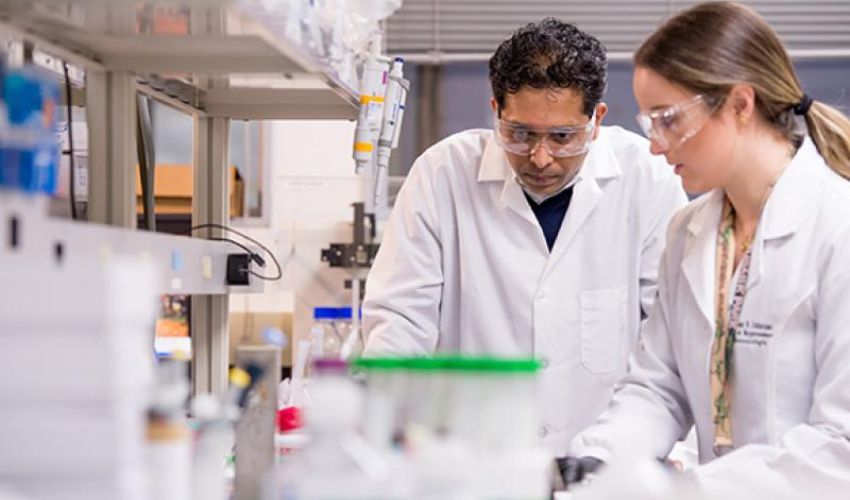Researchers Have Successfully 3D Printed Hair Follicles

Hair is a tricky subject – always desired on the head where it thins out over the years while fought against and declared superfluous on other parts of the body for aesthetic reasons. In this respect, nature is more intelligent than we may want to admit, because the fine hairs on the skin actually fulfill important tasks. For example, hair follicles produce sweat, help regulate body temperature and contain stem cells that promote skin healing. In addition, some medicines and cosmetics enter the body through the skin, which is why the hair follicles on the skin play a crucial role in dermatological tests.
Reconstructed skin models have been developed for such medical tests for decades, but there are still gaps in terms of their complexity and completeness. To date, no skin model has fully developed hair follicle units. However, the steady emergence of 3D bioprinting technologies could close this gap and create biologically and physiologically representative skin models that more closely resemble natural skin and are better suited for efficacy studies than currently available skin models. This is where a study by researchers at the Rensselaer Polytechnic Institute (RPI) comes in.

Until now, skin models from the laboratory have been incomplete and lack hair follicles (photo credits: Chanel)
The scientists, led by Dr. Pankaj Karande, Associate Professor of Chemical and Bioengineering, have succeeded in using 3D printing to incorporate hair follicles into human, lab-grown skin tissue for the first time. This first-of-its-kind example provides a glimpse of how 3D printing could pave the way for future drug testing and skin transplants. “Dr. Karande’s work is a great example of advances being made by RPI researchers at the interface of engineering and life sciences with impact on human health,” said Shekhar Garde, Ph.D., dean of the Rensselaer School of Engineering. “Bringing multichannel 3D printing to the biological realm is opening exciting opportunities that would have been hard to imagine in the past.”
Hair Follicles in 3D Printed Tissue
The study was published under the title “Incorporation of hair follicles in 3D bioprinted models of human skin” in Science Advances in October 2023. Their work differs from previous approaches in that they included hair follicles in skin models for the first time and stands out due to the printing technology used. “The reconstruction of hair follicles using human-derived cells has historically been a challenge. Some studies have shown that if these cells are cultured in a three-dimensional environment, they can potentially originate new hair follicles or hair shafts, and our study builds on this work,” Karande commented on the study’s approach.
For their approach, the researchers cultivated skin and follicle cells in the laboratory and then processed them further as bio-ink in a special 3D printer. To do this, it was crucial to multiply skin and follicle cells in the laboratory so that enough printable cells were available. In a further step, the researchers mixed each cell type with proteins and other materials to produce the printable bio-ink. This was then applied to a wafer-thin needle, allowing the printer to print a skin model layer by layer, simultaneously creating channels for the deposition of hair cells and thus embedding the hair cells.
Over time, these channels around the hair cells filled with skin cells, mimicking the follicular structure of human skin. “Our work is a proof-of-concept that hair follicle structures can be created in a highly precise, reproducible way using 3D-bioprinting. This kind of automated process is needed to make future biomanufacturing of skin possible,” further explained Dr. Pankaj Karande.

3D bioprinting of hair follicles in the skin. (A) Schematic representation of the printing of hair follicle structures within the reconstructed skin models. (B) Live image of a cultured skin model on day 2 (photo credits: Science Advanced)
3D Printing for Transplants in the Future?
Currently, the 3D-printed skin tissue with the hair follicles only survives for around two to three weeks. This short lifespan is far from sufficient for the development of hair shafts. The technology is therefore not yet capable of producing skin grafts that grow hair. Nevertheless, the results of the study show significant progress in this direction. In the future, the researchers also want to focus on extending the lifespan of skin tissue so that hair follicles can continue to mature and be used for drug tests and skin transplants.
“Right now, contemporary skin models — the engineered structures that mimic human skin — are quite simple. Increasing their complexity by adding hair follicles would give us even more information about how skin interacts with topical products,” commented Carolina Catarino, Ph.D., the first author of the study. Indeed, the advancement of the technology could have a positive impact on both regenerative medicine and cosmetic testing by enabling more complex and biologically relevant skin models.
What is certain is that the proof-of-concept work has already helped to underpin the applicability of 3D printing, with 3D bioprinting contributing significantly to a better understanding of the development of skin, blood vessels, sweat and sebaceous glands. “Dr. Karande’s lab is at the forefront of skin tissue engineering. This team has already successfully printed skin with working blood vessels, and this latest research is an exciting next step in developing and testing better treatments for burns and other skin conditions,” concluded Deepak Vashishth, Ph.D., Director of the Shirley Ann Jackson, Ph.D. Center for Biotechnology and Interdisciplinary Studies. You can find the study HERE.
What do you think of 3D printed hair follicles in lab-grown skin? Let us know in a comment below or on our LinkedIn, Facebook, and Twitter pages! Don’t forget to sign up for our free weekly Newsletter here, the latest 3D printing news straight to your inbox! You can also find all our videos on our YouTube channel.
*Cover Photo Credits: Pankaj Karande, left, and Carolina Catarino, right (RPI)







